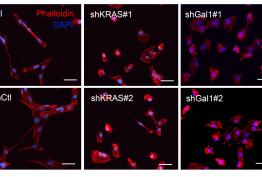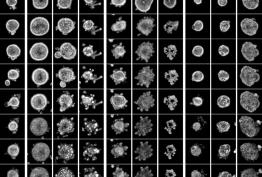To end the Women History Month, at the IIBB we wanted to dedicate a special space to our research groups that are led by women or have women in important work positions for the group.
These groups are:
CELL DAMAGE AND REGENERATION IN ABDOMINAL ORGANS
This line investigates the molecular mechanisms responsible for damage and regeneration in pathologies associated with abdominal organs. Its objective is to find new therapeutic strategies for its prevention or that enhance the regeneration of damaged tissue.
It is led by Dr. Georgina Hotter Corripio, Scientific Researcher of the IIBB-CSIC and has the Specialized Superior Technician Emma Folch Puy
CANCER MOLECULAR TARGETS
The laboratory directed by Pilar Navarro focuses on the molecular mechanisms responsible for the initiation and progression of cancer, with special emphasis on pancreatic cancer. This tumor, in particular pancreatic ductal adenocarcinoma (PDAC), is the third leading cause of cancer death in developed countries and is one of the most aggressive human tumors.
PATHOPHYSIOLOGY OF INFLAMMATION AND TISSUE REGENERATION
The research work carried out by Anna Serrano Mollar's group aims to study the mechanisms related to the regulation of inflammation and tissue regeneration using different models of pancreatic and pulmonary diseases.
"We women have always had difficulties in equalizing our working conditions with men, but the situation has improved over the years, although there is still much to improve" Anna Serrano
LIPIDS AND CARDIOVASCULAR PATHOLOGY
The Lipids and cardiovascular pathology group, led by Vicenta Llorente Cortés, aims to integrate genomic and functional studies in vivo to validate LRP1 as a new therapeutic target and potential biomarker for cardiometabolic diseases and to identify and validate circulating non-coding RNAs as a potential biomarker. in cardiovascular diseases.
CELLULAR NEUROBIOLOGY
The Cellular Neurobiology group, led by Carme Sola Subirana, focuses on the study of neuroinflammation in the context of neurological diseases (Alzheimer's disease, Parkinson's disease, Huntington's disease, multiple sclerosis and amyotrophic lateral sclerosis)
AGING AND NEURODEGENERATION
The Neurodegeneration and Aging group, led by Coral Sanfeliu Pujol, plans to find new therapeutic strategies to combat the underlying alterations in cognitive loss that exist in pathological aging. The research is aimed at activating or reinforcing endogenous neuroprotective mechanisms, either in the neurons themselves or in astrocytic glial cells.
In an interview with Tot MOLINS magazine, Coral Sanfeliu talks about the invisibility of women in science:
Are there few scientific women, or are they invisible?
The two things. There are more and more women in different fields of science, but the proportion is very low when it comes to positions of responsibility. In the successive steps of student, researcher, group leader and director of department or center of research, the female percentage decreases. It is the well-known glass ceiling that we find in many professional fields. In addition, when it comes to disseminating scientific findings, the directors of the teams, who in many scientific areas are mainly men, have more visibility.
SYSTEMS NEUROPHARMACOLOGY
Analía Brotolozzi, principal investigator of the Systems Neuropharmacology group, tells us about her group and her experience in her scientific career
What does your research consist of?
My group's research focuses on understanding the functioning of the brain circuits involved in one of the most severe mental disorders, major depression. We put a main focus on the connectivity between the ventral cingulate cortex and the serotonergic neurons of the raphe nucleus. We try to characterize the synaptic alterations that occur and discover new targets for therapeutic action. In addition, depression is one of the most frequent non-motor symptoms in Parkinson's disease. 40% of patients with PD have depressive symptoms and cognitive alterations. Using animal models of PD, we address the study of monoaminergic circuits other than dopamine, involved in the neuropsychiatric symptoms of PD.
What obstacles have you encountered as a female scientist?
One of the main obstacles in my scientific career was during the maternity stage that practically coincides with the final period of the post-doctoral stage. It is a very demanding period for women because you must compete for stabilization and leadership in the workplace and men have advantages, in general they have an easier time moving up in hierarchical positions. You have the feeling that you must make many more merits to be able to achieve leadership. I believe that this situation will change, but it will take time.
MOLECULAR NEUROPHARMACOLOGY
The Molecular Neuropharmacology group made up of the Principal Investigator Teresa Vilaró and the director of our center and scientific researcher Roser Cortés Colomé, studies the interaction of the cannabinoid receptor type 1 (CBR1) with glucose regulated protein 78 (GRP78) as a possible mechanism regulator of the neuroprotective activity of cannabinoids, the role played by cAMP in the murine model of multiple sclerosis, experimental autoimmune encephalomyelitis (EAE), the identification and validation of therapeutic targets and brain biomarkers of dementia with argyrophilic granules and Alzheimer's disease and serotonin 5-HT4 receptors as a potential therapeutic target for Alzheimer's disease.
BIOLOGICAL AND ENVIRONMENTAL PROTEOMICS
The Biological and Environmental Proteomics group focuses on the research and development of methods and technologies that allow the characterization of biological markers in cellular tissues and fluids, especially those related to pathological processes. One of its main researchers is Monsterrat Carrascal Pérez.
CEREBROVASCULAR RESEARCH
The Cerebrovascular Research group, led by Anna Planas, focuses on inflammation in cerebrovascular pathology, as well as alterations of the immune system in ischemic pathology. Currently, several sublines led by young postdoctoral researchers focus on neurogenesis, signaling, regulation of hypoxia-inducible factor, cell death, and the involvement of the endoplasmic reticulum in these processes. This group has the Higher Specialized Technician Valérie Petegnief.
MITOCHONDRIAL REGULATION OF CELL DEATH
The Mitochondrial Regulation of Cell Death group, which includes the scientific researcher Carmen García Ruiz, focuses on numerous topics of study, among which is the Regulation of oxidative stress of sphingolipids and mitochondria of cell death, the Mechanisms responsible for the transport of cholesterol to the mitochondria and its role in non-alcoholic steatohepatitis (NASH) , hepatocellular carcinoma and neurodegenerative diseases and Translational research in non-alcoholic steatohepatitis (NASH): development of NASH in a humanized mouse model to identify potential targets in human NASH.
One of the main scientists of this group is Anna Moles, who recounts her experience throughout her scientific career:
“My translational research focuses on the identification of new therapeutic targets for the treatment of liver and kidney diseases by studying the cellular and molecular pathways involved in tissue remodeling during fibrosis and cancer. My personal experience with the issue of equality in the academic research sector shows me that there is still discrimination against women and a lack of institutional support, especially during the transition from postdoctoral researcher to principal investigator. This discrimination is directly linked, in most cases, to the lack of family reconciliation and the non-inclusion of periods of maternity leave in the CV evaluations of public and private calls.” Anna Moles talks about her experience as a researcher.
SIGNALING IN CELL DAMAGE AND CANCER
The Signaling in Cellular Damage and Cancer group, whose researchers are Anna Colell Riera and Montserrat Mari Garcia, focuses its research on the study of intracellular and intercellular mechanisms that are activated in response to damage, particularly in liver and neurodegenerative diseases, as well as in carcinogenesis processes. The final objective is that a greater knowledge of the signaling involved in different diseases allows us to develop therapeutic actions that improve the treatment of human pathology.







